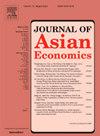How digital technology can improve new quality productive forces? ——Perspective of total factor agricultural carbon productivity
IF 3.4
3区 经济学
Q1 ECONOMICS
引用次数: 0
Abstract
As a catalyst for high-quality economic development, digital technology presents significant opportunities for promoting agricultural new quality productive forces and realizing “dual carbon” goals. This study comprehensively explores the connotation and extension of new quality productive forces, integrating it with the unique characteristics of agricultural production to thoroughly investigate the impact and mechanisms of digital technology on total factor agricultural carbon productivity. The findings reveal a notably positive influence of digital technology on total factor agricultural carbon productivity, primarily driven by advancements in technological catch-up. Heterogeneity analysis shows that digital infrastructure and technology innovation exert a stronger influence. Moreover, regions with robust policy support, particularly in central and western provinces, reap greater benefits from digital technology adoption. Mechanism test indicates that digital technology contributes to agricultural carbon productivity by saving resource input, advancing low-carbon technology progress, and promoting waste recycling. These insights hold significant implications for policymaking endeavors aimed at nurturing agricultural new productive forces and facilitating the modernization of agricultural and rural sectors.
数字技术如何提高新的优质生产力?——农业全要素碳生产率视角
数字技术作为经济高质量发展的催化剂,为推动农业新型优质生产力、实现“双碳”目标提供了重要机遇。本研究全面探索新型优质生产力的内涵与外延,结合农业生产的独特特点,深入探讨数字技术对农业全要素碳生产率的影响与机制。研究结果表明,数字技术对农业全要素碳生产率有显著的积极影响,这主要是由技术追赶的进步所驱动的。异质性分析表明,数字基础设施和技术创新的影响更大。此外,政策支持力度大的地区,特别是中西部省份,从采用数字技术中获益更大。机制检验表明,数字技术通过节约资源投入、推动低碳技术进步、促进废弃物循环利用等方式促进农业碳生产率的提高。这些深刻认识对培育农业新生产力、推进农业农村现代化具有重要指导意义。
本文章由计算机程序翻译,如有差异,请以英文原文为准。
求助全文
约1分钟内获得全文
求助全文
来源期刊

Journal of Asian Economics
ECONOMICS-
CiteScore
4.70
自引率
9.40%
发文量
90
期刊介绍:
The Journal of Asian Economics provides a forum for publication of increasingly growing research in Asian economic studies and a unique forum for continental Asian economic studies with focus on (i) special studies in adaptive innovation paradigms in Asian economic regimes, (ii) studies relative to unique dimensions of Asian economic development paradigm, as they are investigated by researchers, (iii) comparative studies of development paradigms in other developing continents, Latin America and Africa, (iv) the emerging new pattern of comparative advantages between Asian countries and the United States and North America.
 求助内容:
求助内容: 应助结果提醒方式:
应助结果提醒方式:


